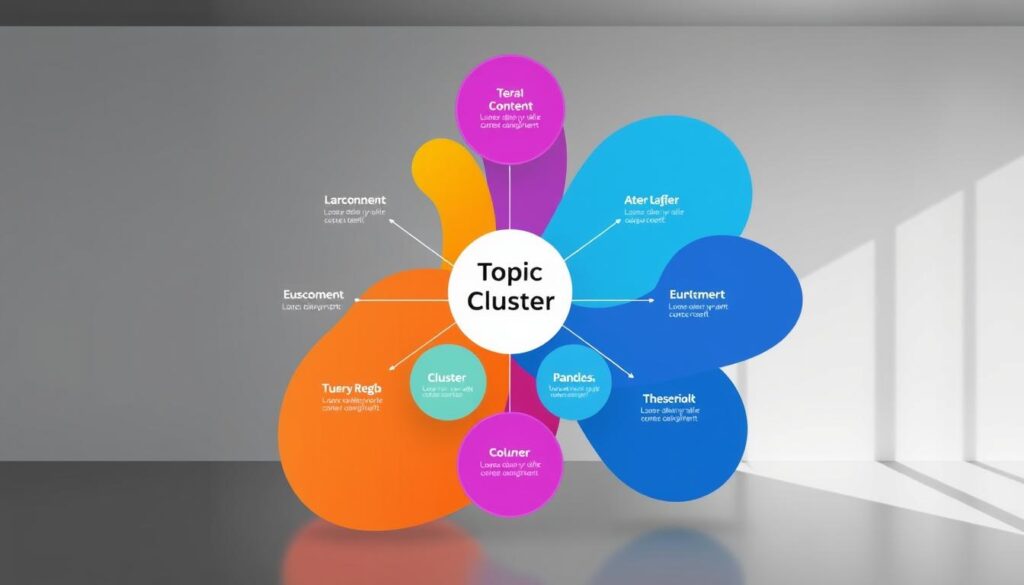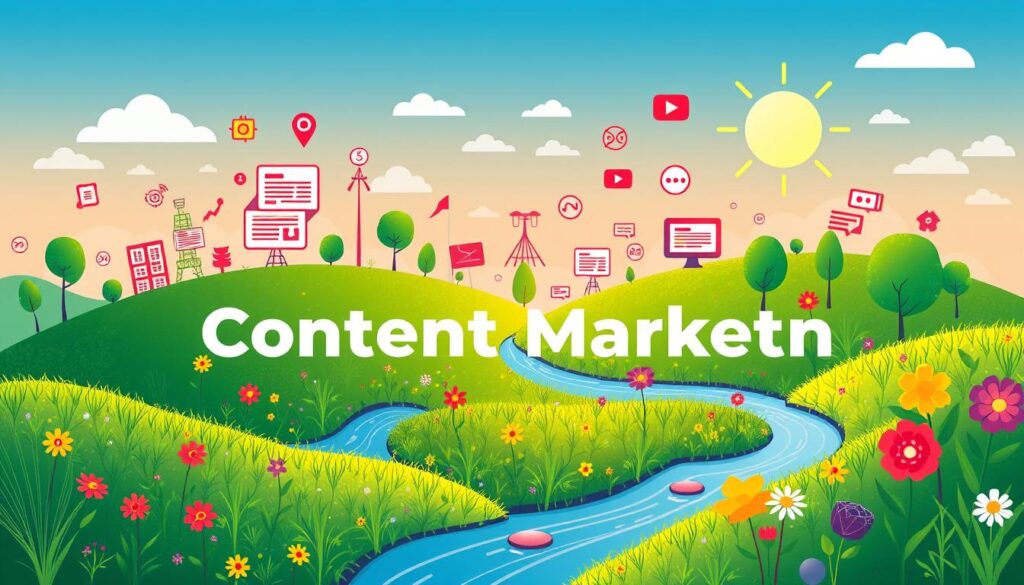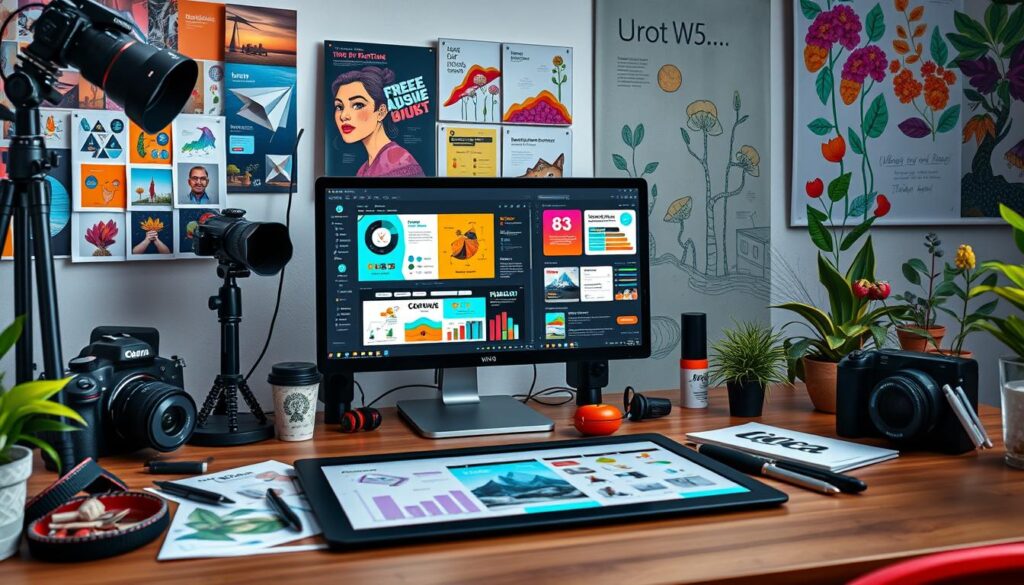|
Getting your Trinity Audio player ready...
|
Ever felt like your website is a hidden gem? You’re not alone. Many businesses struggle to get organic traffic. But there’s hope. Content marketing can change your online game.
Imagine your website rising in search engine ranks. It attracts visitors naturally and turns them into loyal customers. It’s possible with the right SEO content strategy.
Did you know top Google pages have about 1,890 words? Longer, more detailed content does better in search results. It gives readers more value and shows search engines it’s worth sharing.
Quality is key too. 91% of B2B marketers use content marketing to reach their audience. They know valuable content builds trust and educates prospects, leading to more conversions.
Ready to boost your organic traffic? Let’s explore content marketing and SEO strategies. We’ll cover keyword research, on-page optimization, and more. These tools and techniques can take your content to the top and win your audience’s hearts.
Understanding Organic Traffic and Its Importance
Organic traffic is key to a website’s success. It’s when people find your site through search results without ads. This kind of traffic is vital for businesses wanting to grow online and increase sales without spending a lot.
Defining organic traffic
Organic traffic comes from search engines like Google. It’s when users click on results that aren’t ads. These results are based on how well they match the search, making them more reliable and cost-effective for businesses.
Benefits of organic traffic over paid traffic
Organic traffic has many benefits over paid ads. It’s cheaper in the long run because you’re not paying for each click. Also, organic visitors are more likely to convert, leading to better sales. A study shows organic search drives 53% of website traffic, showing its key role in digital marketing.
The role of content marketing in driving organic growth
Content marketing is essential for SEO. By creating valuable content, you can rank higher in search results. This not only brings more organic traffic but also builds trust with your audience. Businesses that invest in content marketing see a big boost in organic traffic over time.
Creating a strong SEO content strategy takes time, but the benefits are worth it. By focusing on organic traffic, you’re setting your business up for long-term online success.
Creating Epic Cornerstone Content
Epic cornerstone content is the heart of your content marketing plan. It’s top-notch, detailed material that makes you stand out. Start with the right keywords and aim to do better than what’s already out there.
Evergreen content creation is vital for making cornerstone pieces last. Choose topics that stay important and useful to your audience over time. This way, your content keeps drawing in visitors and shows you’re a leader in your field.

Using topic cluster models can really help your content strategy. You create a main page that links to related content. This makes your site easier to use and boosts your SEO.
Visuals are key to making your cornerstone content better. Add infographics, diagrams, or charts to grab the attention of visual learners and get more shares. Posts with images can get up to 94% more views than those without.
Don’t forget to update your cornerstone content often. Keeping it fresh and relevant helps you stay on top and keeps your content valuable to your audience.
Keyword Research and Implementation Strategies
Effective keyword research is key to successful content optimization. It helps boost your organic traffic and improve search engine rankings. Let’s look at some powerful strategies for keyword research and implementation.
Identifying Primary and Secondary Keywords
Begin with easy-to-reach keywords that match your content goals. These are often long-tail phrases with less competition but high relevance. As your site grows, add more challenging keywords to your strategy.
Using Keyword Research Tools Effectively
Use tools like SEMrush, Ahrefs, or Google Keyword Planner to find valuable keywords. These tools show keyword difficulty, monthly search volume, and related terms. By balancing these, you can create a strong content optimization plan.
Integrating Keywords Naturally into Content
After finding your target keywords, add them naturally to your content. Optimize on-page elements like titles, meta descriptions, and header tags. Always keep user experience in mind by creating valuable, engaging content. This way, you’ll rank higher in search results and attract more visitors.
Content Marketing for Organic Traffic Growth

Content marketing is a game-changer for boosting organic traffic. It involves creating high-quality, informative content that meets user needs. This attracts and keeps a larger audience interested.
A good SEO content strategy makes your products or services seem like solutions to problems. This way, you use organic search to your advantage.
Consistency is key in content marketing. Regularly publishing content builds momentum and credibility. It keeps you in your audience’s mind.
This approach increases brand awareness and drives potential customers through the sales funnel.
Understanding your audience is crucial for a good content strategy. By defining buyer personas, you can guess what they might search for. This helps you create content that speaks to them.
To make the most of your content marketing, consider repurposing your content. This saves time and reaches different audiences. It also builds a library of content that stays relevant over time.
Optimizing Content for Search Engines and Users
Content optimization is key in your SEO strategy. With over 8.5 billion searches on Google daily, your content must stand out. Let’s look at how to optimize for search engines and users.
On-page SEO Best Practices
Boost your content’s visibility with on-page SEO. Keep meta titles under 60 characters and descriptions under 155. Use clean URLs and include your main keyword in the first 100-150 words. These steps help search engines rank your content better.
User Experience Considerations
User experience is crucial in content optimization. Use proper header hierarchy to make your content easy to read. Add images and videos to keep users engaged and increase dwell time. Remember, 25% of online shoppers start their search on YouTube, showing the value of visual content.
Mobile Optimization Techniques
Mobile searches are on the rise, so optimizing for small screens is vital. Make sure your content is responsive and loads fast on mobile. With 51% of Gen Z women starting searches on TikTok, tailor your content for various platforms. This will help you reach a wider audience.
Leveraging Visual Content for Increased Engagement
Visual content is a key tool in content marketing. It’s processed 60,000 times faster than text. This is why 91% of people prefer it over text.
Adding visuals to your content can lead to great results. Articles with images get double the social shares. Visual content also gets 94% more views than text-only content. These facts show how important visuals are in keeping people interested.

Diversity in visual content is crucial. Original graphics are most popular at 36%, followed by stock photos at 34%. Videos are also becoming more common, with 50% of marketers using them. Long-form videos have seen a huge 11,000% growth in the last decade.
To make your visual content more effective, try these tips:
Create infographics to explain complex concepts
Design custom illustrations to showcase your brand’s unique style
Produce short-form videos for social media platforms
Develop interactive content like quizzes and polls for increased engagement
By using these visual elements in your content marketing, you can increase organic traffic. You’ll also make your content more engaging for your audience.
Building a Robust Content Distribution Strategy
A strong content distribution strategy is key to boosting your online presence. Your amazing content needs to reach the right audience through effective content promotion. Let’s explore some powerful content distribution channels that can amplify your message.
Social Media Promotion Tactics
Social media platforms are goldmines for content promotion. Share your content on platforms where your target audience hangs out. Tailor your message for each platform to maximize engagement. Use eye-catching visuals and compelling captions to grab attention in crowded feeds.
Email Marketing for Content Distribution
Don’t underestimate the power of email marketing. Your subscriber list is a valuable asset for content distribution. Craft engaging newsletters that highlight your latest content. Personalize your emails based on subscriber preferences to increase open rates and click-throughs.
Influencer Partnerships and Guest Posting
Collaborate with influencers in your niche to expand your reach. Their endorsement can lend credibility to your content and introduce it to new audiences. Guest posting on reputable sites is another effective content promotion strategy. It helps build backlinks and establishes you as an industry expert.
Remember, creating great content is only half the battle. A well-executed content distribution strategy ensures your efforts don’t go to waste. By leveraging these content distribution channels, you’ll see a significant boost in your content’s visibility and impact.
Measuring and Analyzing Content Performance
Content performance metrics are key for your organic traffic strategy. By tracking important indicators, you’ll learn a lot about your content’s success. Look at organic search traffic, views, and keyword rankings first. These metrics show which content draws in your audience and how effective your SEO is.
Google Analytics 4 has 14 essential metrics for content marketing. Keep an eye on traffic sources, brand mentions, and conversion rates. These show which channels bring in the most traffic and how well your content connects with your audience. Marketers who check content performance often see a 3 times better ROI.
Social media metrics are also crucial. Brands that track interactions per visit can make their content more engaging. Companies with quality followers see a 33% higher engagement rate. By looking at these metrics, you can improve your content strategy and grow your organic traffic.
Don’t forget about email marketing’s impact on content performance. Companies that focus on open rates see a 20% increase in customer engagement. Better email click-through rates can lead to a 15% increase in sales. By regularly checking these metrics, you’ll be ready to boost your organic traffic and meet your content marketing goals.

